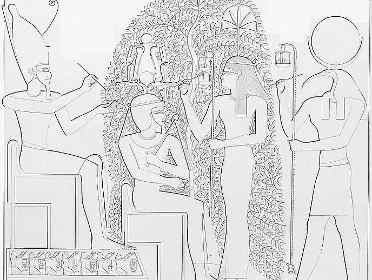History of Ancient Egypt

Unification of Upper and Lower Egypt by Pharaoh Menes (Narmer)
Ancient Egypt emerged in the Nile River Valley what is today modern Egypt. Predictable Nile flooding and fertile soil that was brought with the annual flooding enabled the rise of one of the most powerful ancient civilizations. The foundation of Ancient Egypt is traditionally dated to year 3000 BC when Upper and Lower Egypt where unified by pharaoh Menes (sometimes referred to as Narmer) who founded the 1st dynasty and transfered the capital to Memphis. He divided Egypt on 42 administrative units known as nomes governed by nomarchs who exercised considerable power and occasionally rebelled against the pharaohs.
Egyptian Pharaohs during the Old Kingdom
Egyptian pharaohs were considered divine due to their military and political achievements after the unification of Egypt. During the period of the Old Kingdom (ca. 2688 to 2160 BC), pharaohs were always depicted along Horus, the most important deity in the Ancient Egyptian religion. The period of the Old Kingdom was also marked by construction of colossal monuments of which are best known the pyramids of Djoser and Khufu. However, the Egyptian pharaohs eventually became regarded as divine representatives on Earth “only” due to loss of power to the nomarchs. The power of pharaohs continued to decline and Egypt was once again divided into Upper and Lower Egypt by the end of the 8th dynasty around 2160 BC, while normarchs were fighting against each other for supremacy.
Civil War in Ancient Egypt and the Middle Kingdom under the 12th Dynasty
Nearly one century long civil war known as the First Intermediate Period was won by the 11th dynasty from Thebes which reunited Egypt and started the so-called Middle Kingdom (ca. 2055 to 1640 BC). The capital was transfered to Thebes (today’s Luxor). The Middle Kingdom reached its zenith under the 12th dynasty when Egypt controlled the territory to the Second Cataract of Nile. Senusret III, also referred to as Sesostris III (r. 1878-1839 BC), one of the most powerful Egyptian rulers of the Middle Kingdom centralized the administration and significantly limited the power of the nomarchs.
Hyksos Rule in Egypt
Economic and political decline of Ancient Egypt in the 17th century BC was taken advantage by the Hyksos, an Asiatic people who seized power and ruled Egypt for about one century. The rule of the Hyksos, known as the Second Intermediate Period ended ca. 1550 BC when the Hyksos were expelled by Ahmose I (r. 1550-1525 BC) who founded the 18th dynasty starting the New Kingdom. Pharaohs were once again worshiped as divine beings, while the New Kingdom also saw the introduction of royal brother and sister marriages.
The 18th Dynasty of Egypt and Akhenaten’s Religious Reforms
Pharaoh Thutmose I (r. 1506-1493 BC) and his grandson Thutmose III (r. 1479-1425 BC) extended the Egyptian domain to the Fourth Cataract of Nile and captured Syria. The stability of the Middle Kingdom was severely threatened during the reign of Amenhotep IV (r. 1353-1336 BC) who changed his name into Akhenaten and introduced the worship of Aten, god of the sun. He suppressed the worship of other Ancient Egyptian deities including the god Amun which severely affected the power of priesthood. Akhenaten’s religious reforms were abolished by his successor Tutankhamun (r. 1333-1324 BC) who became famous for his intact tomb discovered by Howard Carter in 1922. Tutankhamun died aged 19 but his death most likely was not violent like it was thought.
The Invasion of the Sea Peoples
The Middle Kingdom reached its height under the 19th dynasty. Pharaoh Ramses II (r. 1279-1213 BC) who is best known for his building activities and military campaigns, in first place against Hittites in the Battle of Kadesh. Egypt retained its leading role in the region under Rameses II’s successors, while Rameses III (r. 1186-1155 BC) successfully defended Egypt from the Sea Peoples who destroyed the kingdom of the Hittites.
The Persian Conquest of Egypt
Ancient Egypt split apart into two states after the extinction of the 20th dynasty. Military leaders, high priests and nobles were fighting for power, while southern Egypt was ruled by Nubia until the arrival of the Assyrians in 664 BC. The reign of the 26th dynasty or Saite Dynasty was marked by rebirth of Ancient Egyptian culture and economy, especially after the collapse of the Assyrian Empire in 612 BC. However, a new power was rising in the Middle East – Persia which conquered Egypt in 525 BC and transformed it into a Persian province.




